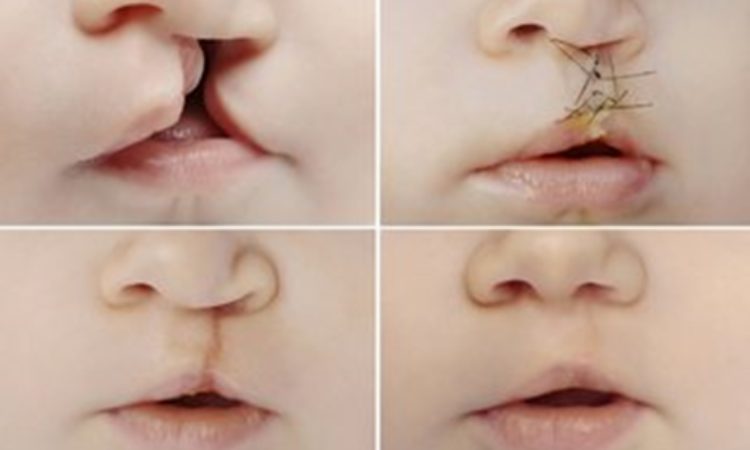
KARACHI: Pakistan is one of the most densely populated countries with approximately 18000 births per day. The incidence of cleft lip and palate in Pakistan is 1 in every 500 which makes it a total of 32 children being born every day with cleft lip and palate. This figure accounts for both syndromic and non-syndromic cleft cases in the country.
Patients born with cleft lip or palate encounter countless functional, psychological and aesthetic challenges right from the start. Besides psychosocial problems, a multitude of health problems like recurrent infections, ear nose and throat problems, speech difficulties, as well as aspiration pneumonia because of ineffective suckling and feeding, makes the management of such a patient not only difficult but makes it essential for all parents to seek immediate parental counselling and treatment of their child at a developed cleft care unit run by a multidisciplinary team.
Pakistan’s health system in relation to the present politically driven devolution process fails to cater to the need of thousands of cleft patients born each day.
In such times of crises and inflation, Al Mustufa Hospital brings a ray of hope to many. The hospital through several years of providing free service has now established a welfare unit with a team of professionals offering complete cleft care free of charge.
The man behind this vision is one of Pakistan’s most senior plastic surgeon, Dr Ashraf Ganatra who has been working relentlessly till date earning the respect and admiration of countless in need.
As an intern and observer at Al Mustufa under Prof Ganatra, I have noticed that the layout of the institution is quite extensive, two theaters are dedicated for cleft care while three operating tables work simultaneously to cope up with the rising number of patients.
The list of patients being operated per week cross 20 on average and a total of 8-10 cases are operated on biweekly. Prof Ganatra’s aim is to establish a solid platform providing consistent cleft care free for every patient following his motto: “Every child has the right to smile and speak normally”
The treatment of Cleft lip and palate has evolved over the years as thousands of clinicians and surgeons from fields of Plastic and Reconstructive surgery, Ent maxillofacial surgery and Psychiatry aggregated their clinical experiences and contributed judiciously to evidence-based practices.
Today we, as clinicians are of the opinion that cleft care worldwide needs a multidisciplinary team of professionals who work synchronously from birth to later stages of life not only treating the deformity but providing a means of parental counseling and establishing support groups aiming towards improved mental health. The goal is to annihilate discrimination while simultaneously boosting the confidence of the growing individual.
Every patient is different and specific cleft care is tailored according to the need, and the patients’ degree of deformity, age of presentation, previous treatment and quality of soft and hard tissue. However, the standard treatment remains the same, involving reorientation of malposed musculature and creating symmetry between the cleft and non cleft sides.
The ultimate goal of cleft lip repair is to restore the sphincter function of the orbicularis oris muscle and obtain a cosmetically favorable outcome for the developing child.
The principles of cleft repair highlight that the columella should come from the nose only and that the lateral lip element should form the central part of the lip regardless of the technique used.
The techniques that resulted in more successful outcomes were adopted worldwide. Popular repair techniques are the Millard,Tennison,Noordhoff and Fisher for unilateral cases and Mullikan and Manchester repair for bilateral lip cases.
The initial markings with precise calculations are necessary which usually comprise of a total of 25 points and then raising the flap in the submucosal plane is crucial for an ideal repair. Dissection in the submucosal plane is necessary to visualize the deeper components and to demarcate the nasal and oral components. Elevation of the lip along the preperiosteal plane of the maxilla is then required where the orbicularis oris is isolated and reoriented in normal fashion suturing the submucosal flaps to the nasal wall to allow for increased surface area and symmetry.
Cleft rhinoplasty is usually required in the same operation in which we separate the skin of the ala from the underlying cartilages, allowing the skin to be shifted over the cartilages to give symmetry and more round shape to the nose.
A registered platform is essential and therefore, inevitable, where all renowned hospitals in Pakistan can collaborate and strive towards treating Cleft patients as a team that will not only aid in audit and data collection for such patients nationwide but simultaneously enhance the teamwork towards excellence.

Dr Saqba Alam
The author is a contributing writer at Dental News Pakistan and a fellow of Maxillofacial Surgery. She can be reached at drsaqbaalam@gmail.com

